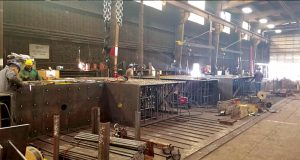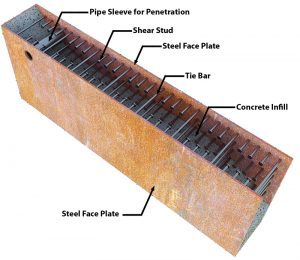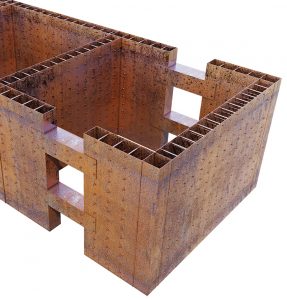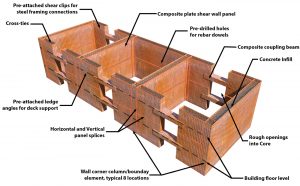Lateral System Innovation for Today’s Construction Challenges
The millennial mindset is saving our profession. A common question from young engineers – “Why do we do things the way we do them?” – can be just as off-putting to us as it is to the Baby Boomer down the hall. The more experienced engineers often side with Gen-Xer points of view and the played-out stories of rotary phones, record players, and the lost art of hand-drafting. All we want to say is: “because we do.”
The thing is, the next generation is not challenging us. Instead, they are challenging the history of how we do things – and it is a good thing they are because many of us have stopped asking, “WHY?”
That question becomes more difficult to ignore when, for instance, a concrete contractor inevitably misplaces an embed to support a steel beam. The Request For Information in the designer’s inbox forces them to spend the time they do not have and money the owner did not plan to spend.
The Millennial mindset is saving our profession because when we get tired of asking why, millennials will jump in and do the asking for us and, in turn, save the profession. Their answers to those questions can revolutionize everything we do.
Innovate
Ron Klemencic, Chairman and CEO of Magnusson Klemencic Associates (MKA), embraces that questioning mindset. At the 2019 NCSEA Summit keynote, Klemencic stood on the stage and encouraged the industry to ask “Why?” because he constantly asks the question himself – with revolutionary results.
Together with his MKA colleagues and AEC partners, he has brought a previously existing idea forward in new packaging to the benefit of the project team, the owner, and, ultimately, the industry. The Coupled Composite Plate Shear Wall – Concrete Filled (CCPSW-CF) system is now known as “SpeedCore.”
MKA had been exploring the idea of a composite sandwich panel shear wall system for a taller building application for several years before making a particularly innovative proposal to Rainier Square Tower developer Wright Runstad & Company: build the first tall building project to use a composite core. Rainier Square Tower is a 58-story, mixed-use, high-rise, currently under construction in the heart of downtown Seattle, Washington.
Composite systems have been used for years, since pumpable concrete was developed and became a structural material. Using the compressive strength and stiffness of concrete to enhance the strength and ductility of steel is ideal, but prefabricated steel-plate composite (SC) wall panel development had gone the proprietary route and lost steam. The nuclear industry saw the safety and speed of the system’s construction and began to employ it in safety-related blast walls for nuclear facilities. They appreciated the additional robustness of the system’s properties, including radiation shielding and resistance to extreme loading. The concept was able to gain popularity as an open-source option, designed by any engineer and built by any fabricator.
SpeedCore
Coupled Composite Plate Shear Wall – Concrete Filled (CCPSW-CF), or SpeedCore, is a non-proprietary, revolutionary method of composite structural-steel framing. The system consists of two steel plates that are held in position by cross-ties and a concrete core.
During construction, the steel faceplates with the steel cross-ties provide stability under construction loading before the concrete infill is placed. In the case of Rainier Square Tower, permanent internal stability trusses were added for ease of transportation and erection (Figure 1). No additional concrete wall formwork is built on-site. The pre-fabricated, panelized module serves as a permanent formwork for the concrete.
Ongoing research has shown that welded shear stud connectors, in combination with fewer, more widely spaced cross-ties are effective in generating composite action as well (Figure 2). After the concrete infill has cured, it acts compositely with the SpeedCore components of plates, cross-ties, and shear connectors. The steel acts as both wall reinforcement and the primary resistance to tension and shear demands on the lateral system. No additional wall reinforcement is placed on-site, greatly expediting wall construction. The concrete infill, working compositely with the steel faceplates, provides overall flexural and shear stiffness to the structure because the confined concrete can resist larger overturning compressive loads under lateral demands.
In the SpeedCore erection schedule, there is no need to advance the core ahead of the surrounding steel frame to achieve simultaneous topping out, as in traditional cast-in-place concrete core construction. The construction schedule is no longer subject to the time and on-site labor costs of placing formwork and rebar. The module plates and cross-ties are prefabricated off-site, leaving the steel erectors to do what they do best: build a kit of prefabricated parts. Embed site placement is a thing of the past, as they now arrive already affixed to the modules. The core is designed for advancing four stories above the surrounding structure in compliance with OSHA erection standards.
At first blush, SpeedCore undoubtedly builds faster. When building with a concrete core, common practice means that concrete, with its days-long curing period, sets the pace. The building schedule is at the mercy of advancing the concrete core. “Why?” The formed core must be high enough that, once steel erection has begun, the erector does not have to demobilize and then remobilize. The concrete pour demobilization, due to high-capacity dissimilar material connections, would have shut down the Rainier Square Tower project without an innovative solution. Once the team behind Rainier Square Tower realized that there would be an eight-week demobilization to complete only one level, and came to grips with all the financial and logistical burdens related to that extended demobilization, they took a serious look at SpeedCore.
Rainier Square Tower
Though MKA had been exploring the SpeedCore concept for several years, no project team was ready to consider the progressive building idea and put pen to paper. A team needed to silence that internal, nagging “why?” to open their minds to an unconventional option. Once SpeedCore was on the table for discussion, Rainier Square Tower’s general contractor, Lease Crutcher Lewis, found the system promised substantial savings. No rebar, no formwork, no curing lag, and no demobilization for outrigger placement all meant a significant reduction to the overall construction schedule.
To lend a sense of scale, the outriggers that provide additional lateral stiffness to the structure require 5,200-kip-capacity, buckling-restrained brace web members. This is one of the highest capacities of BRB elements manufactured. The outrigger loads are very high. For the original design, which used a conventional concrete core, MKA devised an embedded truss connection to transfer the load from the concrete core to the outriggers. In the SpeedCore version, the concrete is wrapped with the steel that is typically cast inside the wall, allowing for more direct steel-to-steel connections. Concrete’s weakness in tension no longer rules the high-capacity connections, and the eight-week construction shutdown is a thing of the past.
Among the laundry list of challenges faced when designing and building, a significant reduction in a schedule is something to which we should be paying attention. The original cast-in-place concrete core schedule estimated topping out 21 months after steel arrival on-site. During the planning phase, Lease Crutcher Lewis was confident that the erection of the SpeedCore version of that same building would take only 12 months. Switching to SpeedCore shaved nine months off the construction estimate – almost 43% of the erection schedule offsetting any additional construction costs associated with the system. The general contractor and the erector bettered their promise by an additional two months, topping out the first week of August 2019. Long story short, Rainier Square Tower is the real-time market test of the SpeedCore System.
Research
Ongoing research is providing a better understanding of the SpeedCore system behavior under lateral loading and how the system’s materials can be optimized. As an early innovator, MKA was not able to take advantage of efficiencies they had theorized that are now being confirmed by research; the designers placed higher importance on a streamlined review schedule and compliance with currently published codes to design and permit the building. For the Rainier Square Tower project, therefore, MKA designed the system conservatively, using the same wall thickness used in the cast-in-place concrete core option and a Seismic Response Modification Coefficient of R = 6.5. MKA’s design method is documented and available for reference in a joint Pankow Foundation-MKA design guide, Design Procedure for Dual-Plate Composite Shear Walls. This is the most current published design method and is conservative for today’s SpeedCore designs.
The Federal Emergency Management Agency’s FEMA P695 Study preliminary findings assert that SpeedCore achieves R = 8, Ωr = 2.5, and Cd = 5.5 – a system efficiency not available during the design phase of Rainier Square Tower. This confers a significant reduction in loads applied in analysis, taking better advantage of the ductility and overstrength of the SpeedCore system. Researchers expect that more testing will facilitate additional optimization, such as increased spacing between ties, a reduction in overall wall thickness, and a reduction in fire protection requirements. Any of these improvements would make the system even more attractive.
There are currently four ongoing SpeedCore research projects. As more research is completed, designers will be better able to evaluate the system’s composite behavior and optimize the system even further. Klemencic, Dr. Amit Varma (Purdue University – Bowman Laboratory), and the American Institute of Steel Construction (AISC) are collaboratively producing a Design Guide to aid engineers in this optimized design.
Combining “Why?” With Good Practice
There is much promise in this system and engineers from all generations must step out of their comfort zone to use it. The project team of Rainier Square Tower took the time and resources to get it right for the benefit of the industry. Early and effective team communication was key in setting up Rainier Square Tower for success. Early mock-ups to evaluate concrete mixes and pouring sequences ensured adequate consolidation and strength. Open-mindedness and realistic goals drove the execution of mock-ups intended to evaluate planned efficiencies for shop and field fabrication methods.
Once the tenants move into Rainier Square Tower and the next innovative building takes center stage, this building will be remembered for pushing the envelope. History will have been made. Asking the question “Why?” might be tiring for those forced to find answers, but it is what makes us better as designers – it is how we ultimately build better. This is the pinnacle challenge of engineering. It is why engineers studied problem-solving in school. It is why they have so much fun in their careers. We should embrace the Millennial mindset and innovate.
For more information about SpeedCore and its use in Rainier Square Tower, visit www.aisc.org/speedcore or contact the Steel Solutions Center at solutions@aisc.org.■
Resources
Bhardwaj, S. R., Varma, A. H., AISC Steel Design Guide 32: Design of Modular Steel-Plate Composite Walls for Safety-Related Nuclear Facilities, American Institute of Steel Construction, 2017, 1)
Ramesh, S., Kreger, M.E., Bowman, M.D., Design Procedure for Dual-Plate Composite Shear Walls. School of Civil Engineering Purdue University, June 2014.




